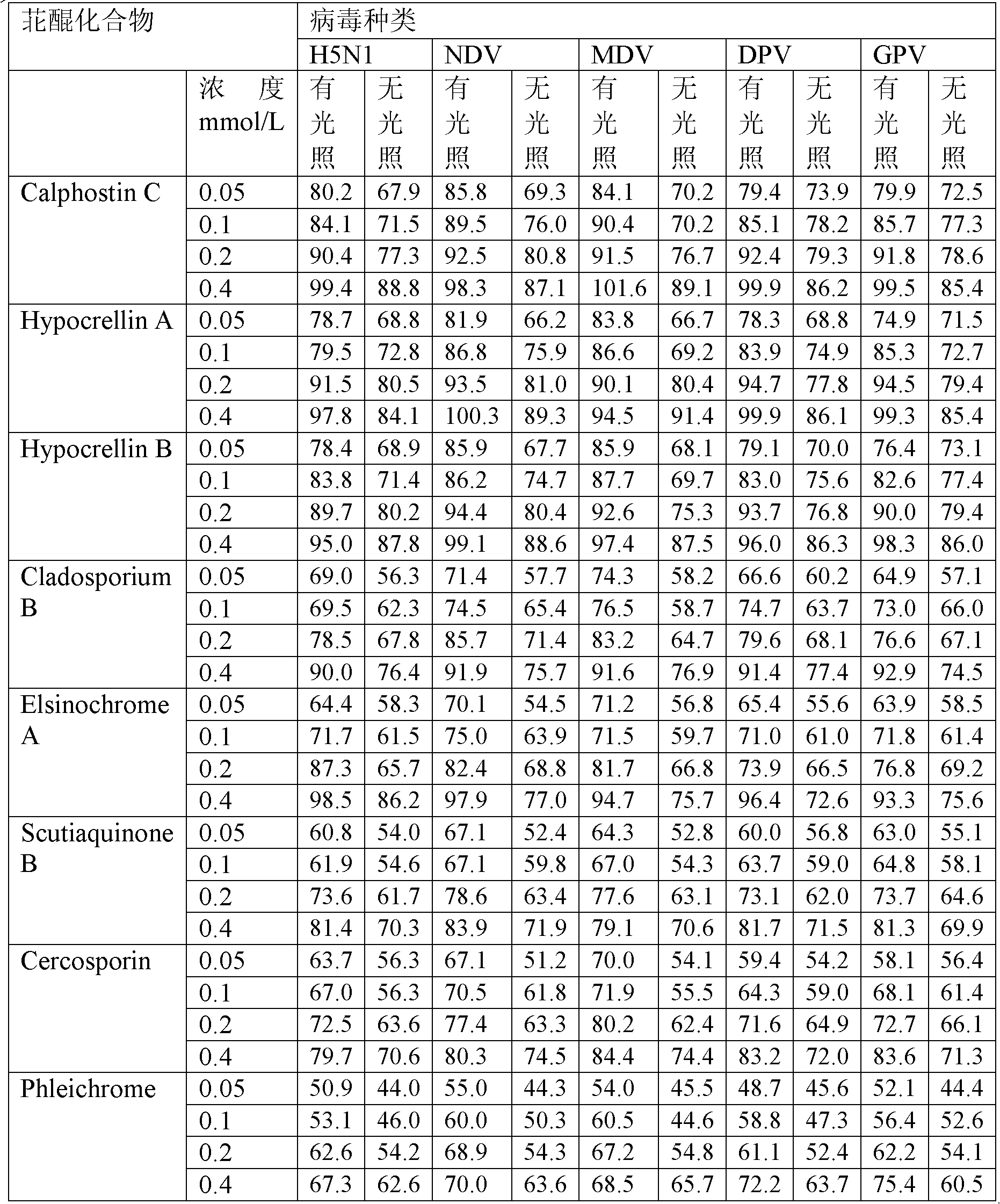Application of perylenequinone compound in preparation of feed for preventing and treating poultry viruses
A compound and poultry technology, applied in animal feed, animal feed, applications, etc., can solve problems such as easy decomposition, hypericin cannot be effectively used, and hypericin’s chemical properties are unstable
- Summary
- Abstract
- Description
- Claims
- Application Information
AI Technical Summary
Problems solved by technology
Method used
Image
Examples
Embodiment 1
[0043] Example 1: In vitro antiviral experiment of perylenequinone compounds
[0044] (1) Preparation of embryonic fibroblasts grown from chicken embryos for in vitro anti-virus experiments
[0045] Take chicken embryos about 11 days old and place them on an egg rack with the air cell facing up, sterilize with iodine for 5 minutes, and remove the eggshell in the air cell after deiodination with alcohol; take out the chicken embryo with sterile elbow tweezers Remove the head, claws and viscera in a bacterial plate; transfer the chicken embryo to a sterile small beaker, wash it with Hank's solution for 3 times, and cut it into about 0.5-1mm with small sterile scissors 3 Small pieces; wash 3 times with Hank's solution, add an appropriate amount of 0.25% trypsin, and digest in a 37°C water bath for about 10 minutes; add growth solution or serum to stop the reaction, blow gently with a pipette, add growth solution to resuspend; cell count, Pack cell flasks according to 4 million t...
Embodiment 2
[0072] Example 2: Anti-H5N1 virus experiment of solid-state fermented hypocrellin added to chicken feed
[0073] The basic dietary formula of chickens in the experiment is: corn 60%, millet 5%, sorghum 4.2%, wheat bran 5%, bean cake 8%, fish meal 8%, meat and bone meal 3%, blood meal 5%, stone powder 1.5%, salt 0.3 %. The basic daily ration is powder, which is crushed with a 1.8mm sieve.
[0074] Hypocretin is produced by solid-state fermentation, corn is the main raw material, and 2% glucose and 0.2% KH based on the weight of corn are added 2 PO 4 , 0.04% MgSO 4 ·7H 2 O. Add water and mix the material to make it wet, control the ratio of material to water at 1:0.7, sterilize at 121°C for 45-60 minutes, and add 10% liquid Shiraia sp.SUPER-H168 seeds after cooling. Both the initial pH and the pH of the fermentation process are natural, the fermentation temperature is 30°C, the humidity is controlled at 90% during the fermentation process, and the fermentation ends after 1...
Embodiment 3
[0086] Example 3 Anti-NDV virus experiment of liquid fermented hypocretin added to chicken feed
[0087] The experimental basal diet was the same as in Example 2.
[0088] Hypocretin is produced by liquid fermentation method, and the culture medium per liter consists of: glucose 20g, peptone 50g, potato 200g, (NH 4 ) 2 HPO 4 2g, KH 2 PO 4 2g, MgSO 4 0.5g / L, sterilized at 121°C for 20min, then add 10% liquid bamboo yellow fungus seeds after cooling. Both the initial pH and the pH of the fermentation process are natural, the fermentation temperature is 30° C., and the fermentation ends in 72 hours. The fermented liquid was removed by centrifugation to obtain mycelium, which was dried at 60°C. It was determined that hypocrellin A accounted for 8.1%, hypocrellin B accounted for 1.3%, and the total amount of other perylenequinone compounds accounted for 0.2%.
[0089] Select 80 1-day-old broilers with basically the same body condition (average body weight is 36g), and divide...
PUM
 Login to View More
Login to View More Abstract
Description
Claims
Application Information
 Login to View More
Login to View More - R&D
- Intellectual Property
- Life Sciences
- Materials
- Tech Scout
- Unparalleled Data Quality
- Higher Quality Content
- 60% Fewer Hallucinations
Browse by: Latest US Patents, China's latest patents, Technical Efficacy Thesaurus, Application Domain, Technology Topic, Popular Technical Reports.
© 2025 PatSnap. All rights reserved.Legal|Privacy policy|Modern Slavery Act Transparency Statement|Sitemap|About US| Contact US: help@patsnap.com



